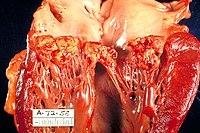
Photo from wikipedia
Background Several comorbidities contribute to an increased risk of infections in Parkinson's disease (PD) as the disease progresses. However, few studies have examined the correlation between sepsis and PD. Aim… Click to show full abstract
Background Several comorbidities contribute to an increased risk of infections in Parkinson's disease (PD) as the disease progresses. However, few studies have examined the correlation between sepsis and PD. Aim The aim of this study is to disclose the presentation and outcome of serious infection in patients with PD in the emergency department. Methods This retrospective cohort study enrolled patients with PD who had serious infection and were admitted to the emergency department between January 2007 and December 2013. For clinical comparison, we compared the clinical features, laboratory data, and outcomes with those of age- and sex-matched patients who had serious infection but not PD. Results There were a total of 1,200 episodes of infected PD patients and 2,400 age- and sex-matched infected patients without PD as disease controls. PD patients had fewer comorbidities and lower severity of infectious disease but longer hospital stays than control group patients. The incidences of respiratory tract and urinary tract infections were higher in PD patients. The levels of inflammatory and organ dysfunction biomarkers in PD were lower and compatible with the severity of infectious disease. A total of 86 (7.2%) infected PD patients died during the 28-day admission compared to 339 (14.1%) in non-PD patients. Serum C-reactive protein, bandemia, and lactate could be used to predict mortality in infected PD patients. Conclusions In infected patients with PD, respiratory and urinary tract infections were the two most common infectious sources. Empiric therapy based on experience could treat both respiratory and urinary tract infections. Early diagnosis and treatment are essential for survival.
Journal Title: BioMed Research International
Year Published: 2018
Link to full text (if available)
Share on Social Media: Sign Up to like & get
recommendations!